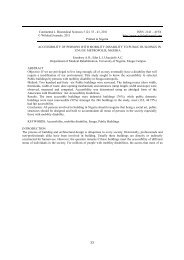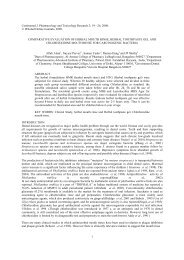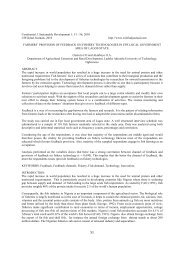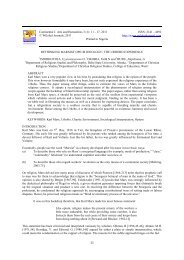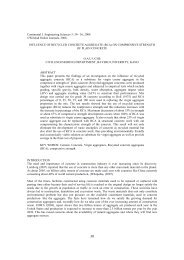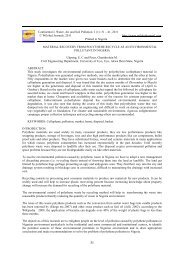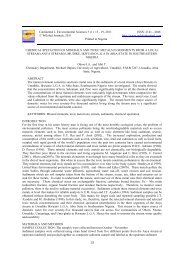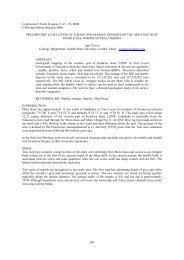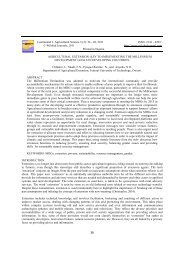Vol 2 - Arts and Humanities - Wilolud Journals
Vol 2 - Arts and Humanities - Wilolud Journals
Vol 2 - Arts and Humanities - Wilolud Journals
You also want an ePaper? Increase the reach of your titles
YUMPU automatically turns print PDFs into web optimized ePapers that Google loves.
Rasak Bamidele: Continental J. <strong>Arts</strong> <strong>and</strong> <strong>Humanities</strong> 2: 7 - 16, 2010of their dead gr<strong>and</strong>parents returned back as the new born child. It’s the name of this gr<strong>and</strong>parent that will be given tothe child. Other sources of Igbo names are of event like, giving praise to God, market days <strong>and</strong> nature- this is when achild is given a name relating to springs or rivers. This is common among the Igbo because they believe springs arethe source of life.Interpersonal communication exists in the culture of naming ceremony, since it involves interaction between people.A woman who has just given birth to a child realizes that she immediately starts sharing meaning with her baby. Forexample, the cry of the baby will communicate to her that the child is uncomfortable <strong>and</strong> needs her attention. (Ojike,2005), says that in Igbo l<strong>and</strong> women who are well wishers <strong>and</strong> relations of the family blessed with a new childcommunicate the good news of the arrival of a new child to others by rubbing can wood on their bodies, <strong>and</strong> whenanybody come in contact with them, such a person will know that a child has just been newly born. He/she can thenask who <strong>and</strong> where the child is born so that he/she can go <strong>and</strong> pay a congratulatory visit.Materials used for Naming CeremonyAmong the Igbo people, the naming ceremony day, is a day in which all the relations <strong>and</strong> friends that are present atthe ceremony feast together (Ilogu, 2002). One of the most important things at the ceremony is palm wine. Thefather of the child must make sure there are enough kegs of palm wine for his guests. The significance of palm wineis that, it is used to appease <strong>and</strong> invite the ancestors into their midst. Kola nut is also used for prayer; it is thenbroken in pieces so that all that are present will eat from it. Women from the family where the ceremony is beingperformed cook different types of food from which the family shrine is first fed <strong>and</strong> then the guests. If the family isone that pays prominence to God, they take part of the food to the pastor’s house or the priest.As in the Igbo culture, among the Yoruba people, the naming of a child always attracts ceremonies. The ways theseceremonies are performed differ from one compound to the other. The naming ceremony is generally referred to as“Ikomojade” as earlier mentioned. It is the day in which the child is for the first time, brought out of the room.Hence, the term applies to the event that is, bringing out of the child. Materials used for naming ceremony amongthe Yoruba people differ from one family to the other. However, there are some common items according toDaramola <strong>and</strong> Jeje, (1995); these are bitter kola, salt, honey, cold water <strong>and</strong> hot drink. Adeoye (1992) added fish <strong>and</strong>“Ataare” (Alligator pepper).Each of these materials has its own significance in the ceremony <strong>and</strong> in the life of the child to be named. The headof the family in performing the rites involved in the ceremony takes bitter kola <strong>and</strong> says to the child;( mentioningthe name he has been given) as this bitter kola is strong, so must you be strong in life.He again takes salt, puts it in the child’s mouth <strong>and</strong> says: this salt, as this salt is sweet, so must your life be sweet,<strong>and</strong> because life is as sweet as salt, you should stay <strong>and</strong> eat the salt with us. Honey <strong>and</strong> salt signify almost the samething. Water indicates that the child’s life shall be as cool as water. With the hot drink in h<strong>and</strong>, he says; gin does notfade, may you stay long with us <strong>and</strong> not fade away.The fish signifies food that the parents of the child eat <strong>and</strong> that important people eat meat or fish, the child shouldtherefore grow up to be an important person who will eat meat or fish. One of the seeds of “Ataare” (Alligatorpepper) is removed <strong>and</strong> put on the child’s lips; it signifies that the child should grow up <strong>and</strong> multiply just like Ataare(Alligator pepper) has many seeds.Theoretical FrameworkIn this study the theory of ethnography was taken in consideration- the science of ethnography is the scientific studyof a race or group of people. People without culture are dead. Culture is the totality of the people’s ways of life,beliefs <strong>and</strong> values. It is a regular <strong>and</strong> routine demonstration of the human power, body <strong>and</strong> spirit; personal <strong>and</strong> grouprelationship <strong>and</strong> community responsibilities. It encompasses the arts, music, <strong>and</strong> folklore intellectual development,social institutions, for which the community or society is identified. Culture is not static. It evolves with thedevelopment <strong>and</strong> advancement of the environment in which the society strives. For instance, with the advent ofreligion, the belief of culture of the people is bound to change in response to the new belief system.10






